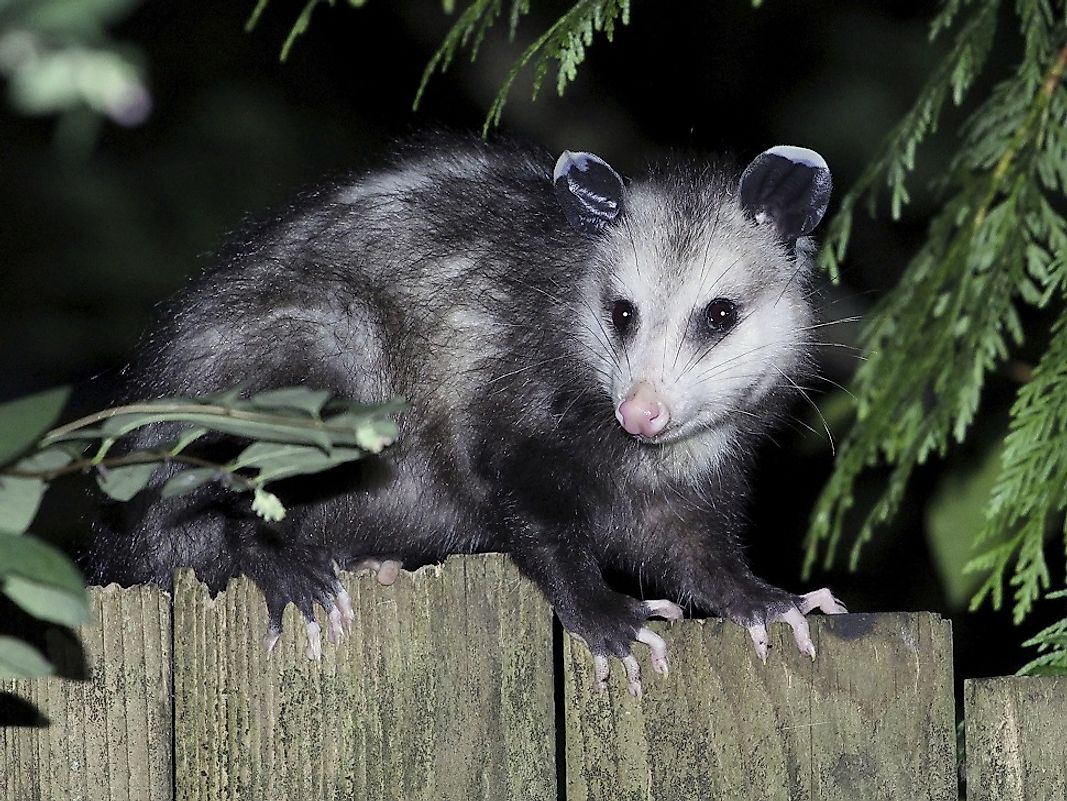Virginia Opossum Facts: Animals of North America

5. Physical Description
Whether fair or not, Virginia Opossums are often characterized by a long face, that many people consider to resemble a big, ugly “grin. Adults usually weigh between 6 and 13 pounds, and their bodies, from nose-tip to tail-tip, are between 2 and 3 feet long. Up to half of this, however, is often in their thin, fleshy tails alone. Its binomial name, Didelphis virginiana, refers to the animal being “two-wombed” and hailing from an area that includes modern-day Virginia. They are a distant cousin of the Australian Possum, and in Mexico Virginia Opossums are known by variations of the name tacuachi. The species crossed from the lands of their South American relatives into Central America by way of the Panamanian Isthmus several million years ago.
4. Diet
Virginia Opossums are omnivores, and will eat just about anything. If you don’t believe this, just ask any homeowner in the rural Southeast United States what often happens if you leave trash out overnight on your back porch there. In the wild, Virginia Opossums will eat insects, crustaceans, mollusks, frogs, and reptiles living near streams, other small animals, and the meat and eggs of birds that make their nests on or close to the ground. Despite such a wide range of animal foods, Virginia Opossums get plenty of produce in their diets as wells, and they often exhibit special inclinations towards eating fruits, berries, nuts, and seeds. As nocturnal animals, most of this fare is consumed in the dark while many of their predators sleep.
3. Habitat and Range
The nocturnal Virginia Opossum, or North American Opossum, is the only marsupial to be found naturally occurring in the New World north of Mexico. With more than 200 marsupial species naturally present in and around Australia, more than a hundred more additional species are native to South and Central America, whereas this curious marsupial stands alone as the only creature of its kind in Canada and the United States. The Virginia Opossum has long been found in much of what is now Central America, Mexico, and the United States east of the Rocky Mountains. Increasingly, however, they have been pushing their bounds into Southern Canada, and have been intentionally introduced to the West Coast of the US during the past century. Due to their propensities for scavenging and thwarting predators, low susceptibility to diseases, and high birth rates, Virginia Opossums are considered to be animals of “least concern”. Immunologists may learn a great deal from Virginia Opossums, in that they have very low rates of diseases common to other wild animals, namely Rabies. This is partly due to their body temperatures, which are lower than those of many other mammals. Considered an overpopulated nuisance, may are trapped and poisoned where they are common, while some are hunted for their meat. Due to their high populations and ability to live in close proximity to humans, they are often seen on the side of highways as “roadkill” struck by motor vehicles. Despite being woodland creatures, human development seems to have little impact on their lives in comparison to how it has driven some other North American species to extinction or migration to new homes. In fact, as adaptable in lifestyle as they are versatile in diet, many Virginia Opossums seem to revel in sleeping in storage buildings and eating from dumpsters.
2. Behavior
Virginia Opossums have a large number of predatory enemies, and have come up with some unique ways to elude them. The term “playing opossum”, alluding to faking one’s incapacitated state, refers to the Virginia Opossums’ habit of collapsing and feigning death when in danger of losing its life to trick attackers. They may remain motionless for long hours, slowing their heart rate and emitting noxious gases to ward off carnivores. Still, due in large to their many predators, a relatively small percentage of babies survive into adulthood. Skilled climbers, Virginia Opossums usually make their homes in tree-lined within and around trees, but may take up residence in farmers’ barns and peoples’ sheds as well in search of warmth. While very active at night, they hide and sleep during the daytime. In the summer, they are lively travelers, and will rarely sleep in the same dens on consecutive nights.
1. Reproduction
Virginia Opossums are marsupials, meaning that females lack “functional” placentas for their babies to grow within. For this reason, while still in developmental fetal stages within the mother, babies are birthed into a pouch outside of the mother, wherein they grow and are sheltered as they nurse on their mothers’ teats until they are strong enough to be exposed to the external environment. Female Virginia Opossums normally have two litters per year, each having around 5 to 8 tiny opossum babies, which feed upon 13 nipples within the fur-lined pouches. Courtship usually involves males making a series of “clicks” to attract females to copulate with. Males do not help the females in rearing young, and leave her after mating. Young Virginia Opossums leave their mothers’ pouches and wander around on their own after they are around 4 months old and approaching 1 pound in bodyweight. The rapidity of this birth cycle is amazing, as the still-developing young will be birthed into the “marsupium” (the mother’s pouch) in around 12 days after conception. These infants are so small that 20 of them could fit inside of a teaspoon.











